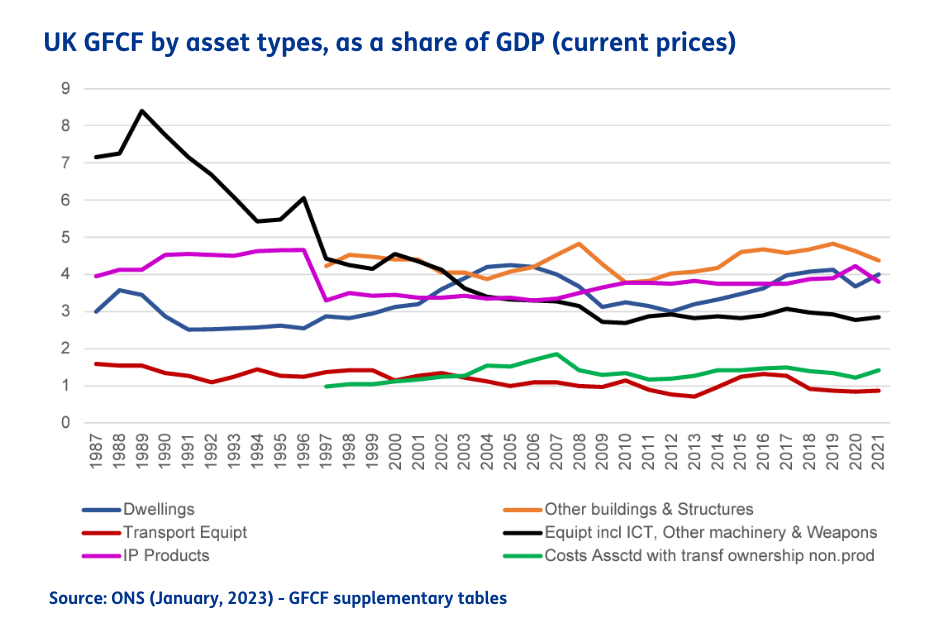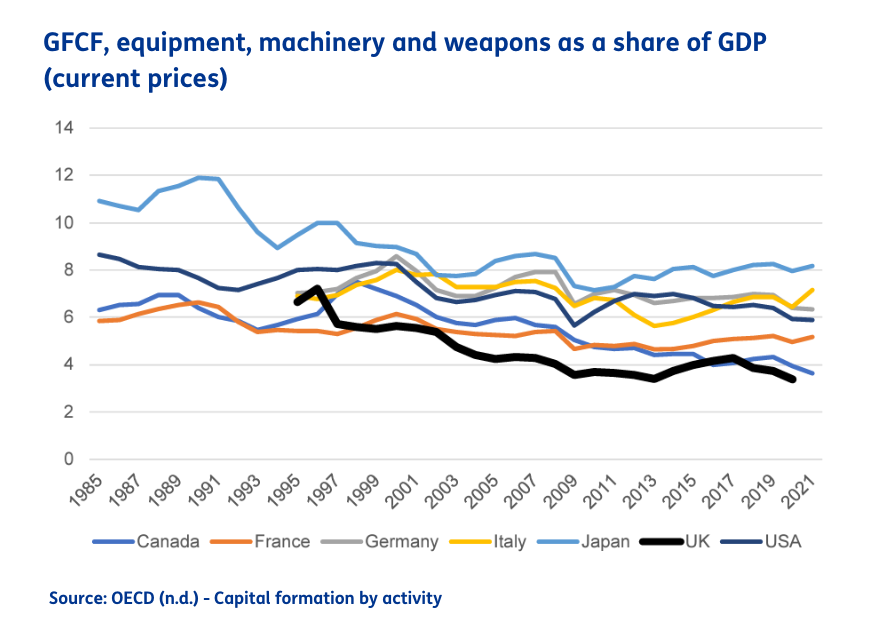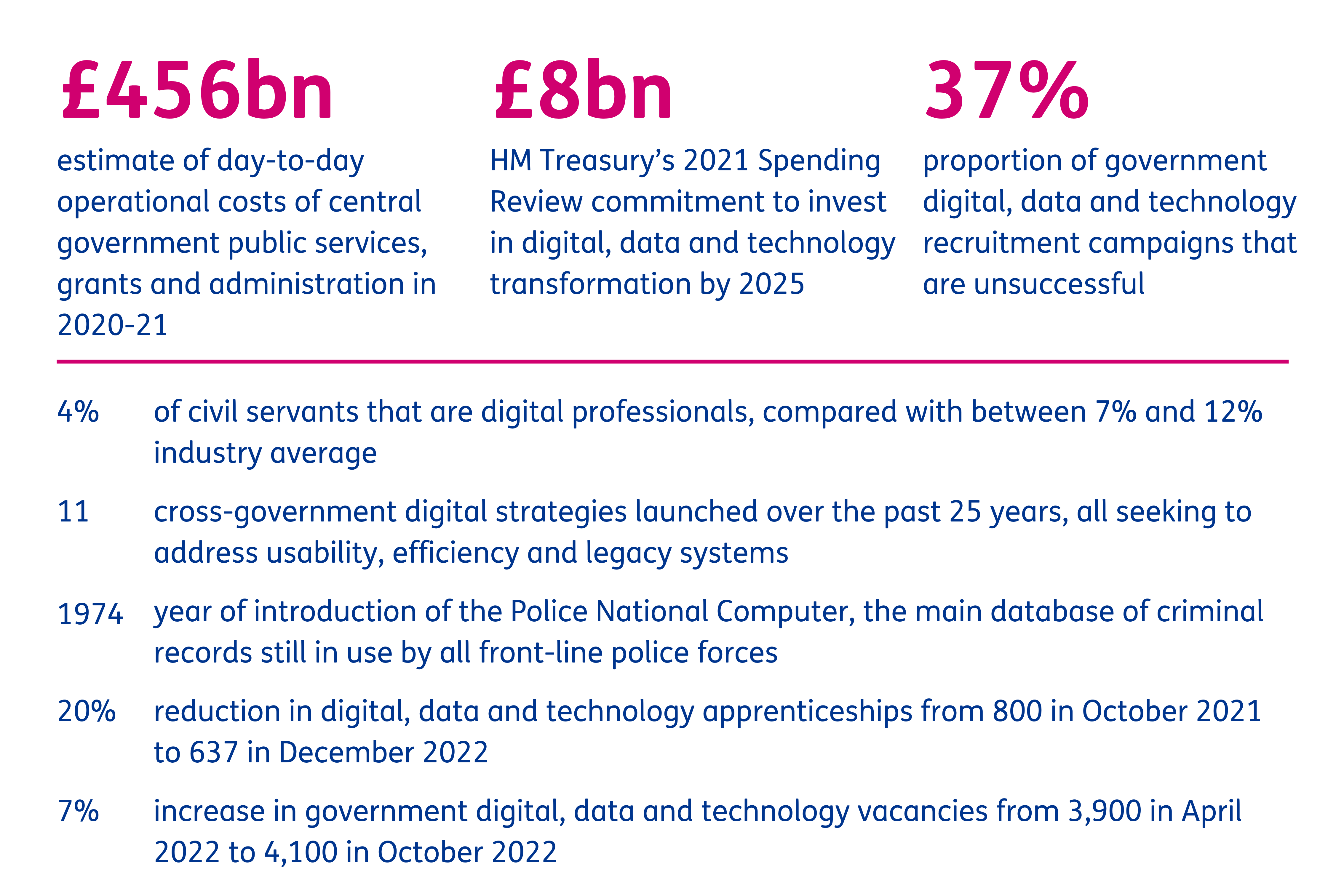Making good use of technology is vital to the future of public service delivery. As the government put in its ‘Transforming for a digital future’ policy paper: “Digital transformation has unrivalled potential to improve the lives of citizens throughout the UK and modernise the way government works.”
Looking at much of today’s tech-enabled society, this potential might seem obvious, but the public sector has not kept pace with the technological progress we have seen in other parts of life. We can order our supermarket shop in an app, track our sleep using our watches, share our log in details automatically with our face ID and yet sit on the phone in the 8am rush to book a GP appointment.
The gap between the quality of services citizens expect from the private sector and those they receive from the public sector has grown. Government departments and agencies are struggling to harness the benefits of tech-driven ways of working, and as a result are unable to deliver citizens a service they expect.
For government to meet these challenges, well-managed deliberate investment in technology is needed.
A lack of technology investment has hindered productivity
-
The public sector is 5.7% less productive than before COVID-19.
-
The UK invested just 3% of its GDP in equipment, including technology, in 2021.
Making effective use of technology is key to making public services more productive. According to Treasury figures, public services are estimated by the Office for National Statistics to be 5.7% less productive than before the pandemic; in the 2024 Budget government set out investment plans to help close this gap. These proposals focus on technology investment, including £1bn to help deploy automation in the National Health Service, as well as £2bn to update fragmented and outdated IT systems across the NHS. An additional £800m will also be spent on new technology in central government and in areas such as policing, justice and planning.
This investment is needed as, historically, the UK economy as a whole has invested comparatively little in technology. Spending on equipment, including information and computing technology, has fallen from just under 8% of gross domestic product in 1990 to less than 3% thirty years later in 2020, according to analysis from the Bennett Institute for Public Policy.

This investment trajectory puts the UK at the bottom of international investment rankings, leaving the UK lagging behind peer G7 nations in the investments it makes in technology in both public and private sectors.

This lack of investment has created a public sector infrastructure gap. According to the Institute for Government’s Performance Tracker of public services, historic underinvestment in capital is having “a serious impact on the productivity of public services, with problems with both the quality and quantity of capital assets”.
"Teachers, nurses, doctors and social workers all find it harder to do their jobs in crumbling and cramped buildings, on old computers running out-of-date software, and without access to the latest equipment."
Institute for Government
The same is true for civil servants working in government departments.
As professor Bart van Ark, the managing director of the Productivity Institute, puts it, “digital transformation is a key driver for innovation in the public sector, as technology can simplify, streamline and enhance the delivery of products and services.”
The government needs to acknowledge that the capacity to deliver more with less has been exhausted. Investment is now needed – in people, technology and, importantly, purpose – to create better services.
Technology investment is needed – but must be linked to purpose
-
Treasury allocated £8bn for investment in digital transformation from 2022-23 to 2024-25.
-
Total public sector IT spending was around £17.3bn in 2021-22, with £5.6bn spent with government's largest tech suppliers.
Baringa believes that public sector organisations need to have a clear purpose when aiming to improve productivity.
Government departments should clearly articulate what they exist to do and the outcomes they will deliver for citizens and society. This purpose should fit within the government’s overall objectives.
Focusing on a clear purpose will also help get technology investment right. Leading on outcomes means stopping the product-centred view of transformation, which has improved products one by one without providing a better service. Government must concentrate instead on an approach that creates a technology ‘fabric’ that can integrate services around outcomes – a ‘platform’ approach.
This ‘platform’ approach will allow departments to think holistically about what they need to achieve – improving user experience, cutting processing times, boosting staff productivity, reducing costs – rather than as lots of individual projects. A high profile example of the public sector taking a platform approach is the NHS’s Federated Data Platform – aiming to create a national infrastructure for organisations to appropriately share and apply patient data, in a way that meets patient’s information governance needs. This platform enables integrated services such as bed management to be built efficiently and securely, rather than investing in a standalone “Bed Management System”.
A joined-up methodology will also help identify operational inefficiencies where transformation (covering people and processes as well as technology) can lead to the greatest benefits. Thorough root cause analysis should ensure that underlying problems are identified and addressed, rather than just papered over by a new piece of technology that doesn’t resolve the underlying issues and costs even more to integrate into legacy systems. A good example of a blended digital and business team transforming a non-digital service while considering what users really needed was the transition to Individual Electoral Registration, which resulted in the Register to Vote website.
There are lots of good examples of effective digital service transformation across Government.
Where digital service transformation succeeds civil servants from teams outside digital or transformation functions are involved. Too often tech programmes do not gather the input of people on the frontline, leaving those with the greatest knowledge on the sidelines. This knowledge must be harnessed for success. Technology must complement public service operations, not aim to compete with it. Baringa have supported a large public organisation dealing with complaints demonstrating just this – the immense potential for productivity improvements when public organisations get the technology to complement their operations, in this case saving 600 hours of capacity per month. More detail on this case study will follow in a subsequent article in this series.
Commercial processes must also reflect this purposeful mindset. Technology investment should be strategic and long term, and yet procurement processes often drive technology investment down the route of high-volume, outsourced solutions.
Research from public procurement experts Tussell found total public sector IT spending was around £17.3bn in 2021-22, of which around £5.6bn was spent with large technology firms known as ‘strategic suppliers’ – around one-third of all tech spending. Government needs to be wary of falling into a pattern of large monolith systems which are expensive to maintain, instead considering the technology ecosystem as a whole. There needs to be complementary investment in in-house capability to build and maintain services, not just buying products from suppliers that then need to be constantly patched with other systems when the jigsaw puzzle changes.
Getting the relationship right between government and private sector contractors is therefore vital. Clearly articulating purpose and outcomes will enable better value for money in technology investment spent with the private sector, rather than focusing on specific product requirements which are likely to change and flex throughout the delivery of a technology programme.
Get technology investment right by investing in more than just technology
-
Just 5% of civil servants are digital professionals, lower than other industries.
-
37% of government digital, data and technology recruitment campaigns are unsuccessful.
To make tech investment work, government must also invest in more than technology. As we have highlighted, people and technology work together to help government meet its purpose, so investment in people is needed to make the most of new processes and technology.
This is what economist and Bennett professor of public policy at the University of Cambridge Diane Coyle calls "complementary investments” – and a lack of them is what contributes to the paradox that digital innovations have not yet led to widespread productivity improvements.
“How we spend our days, how we work, how at least some businesses are organised has changed dramatically without moving the dial on measured productivity,” she notes.
It is likely that data and software-enabled change is inherently harder to adopt than previous technologies, Coyle says, so support for people throughout this transition is crucial. She affirms that organisations that have invested more in their ‘organisational capital’ as compared with their counterparts have seen greater adoption of, and therefore benefits from, the money spent on technology. This is true across all layers; there needs to be education at senior levels to understand how to deliver change effectively, and recognition that the challenge is significant and will take time to address.
"Given the policy focus on ensuring the UK is a world leader in at least some areas of AI, the skill shortfall is likely to need even greater focus"
Diane Coyle
Government must be ready to pay for the skills it needs. But while civil service workforce reports show that the proportion of civil servants working on digital and data has nearly doubled in the last five years, growing from 2.8% in 2018 to 5% in 2023, the National Audit Office (NAO) says this is still below a broader industry average of between 8% and 12%. Further, as the NAO noted last year, 37% of government digital, data and technology recruitment campaigns are unsuccessful.

And it is not just in professionals in dedicated digital roles where better expertise is needed.
Research by Global Government Forum supported by Google Cloud has found that the overall digital skills of civil servants working in all professions are lacking – whilst three quarters of civil servants believe that technology is the key to unlocking public sector transformation, 78% of them would like to receive more digital skills training from their employer.
While officials have high levels of skills in using collaboration tools in the age of flexible working, the research found they lack skills in other areas of technology needed for future public service delivery, such as data analysis, use of cloud infrastructure and artificial intelligence. For example, over a third of respondents say they have little or no knowledge in how artificial intelligence, machine learning and automation can be deployed to improve public services.
We know the potential benefits of AI within public services are enormous, with the opportunity to achieve an unprecedented Return on Investment. However, without the critical knowledge of how to harness AI to the government’s benefit, these opportunities could fall by the wayside.
This underlines the need for government to boost the digital skills of civil servants to make the most of the money spent on technology, and provide better services in turn.
Baringa has supported government organisations to invest in technology – and the complementary areas that make the most of this spending. Click here for the other articles in this series and keep your eyes peeled for a real-world example of how to improve productivity through purpose-led digital investment: implementing AI into a major UK regulator’s core service.
Our Experts



Related Insights

Five AI pitfalls that governments must avoid to unlock productivity benefits
Discover the five key mistakes organisations make when using AI – and how Government Departments can avoid them.
Read more
Using AI to save hundreds of hours capacity per week for a customer services organisation
How do you improve productivity through purpose-led digital investment? Discover the four steps that enabled our client to find a resolution through purpose-led investment in AI.
Read more
Boosting productivity in UK public service digital transformations
Public service organisations should focus on delivering more strategic outcomes with less transformation budget by embracing three key shifts
Read more
From engagement to improvement: how empowering civil servants leads to better outcomes
Taking a people-led change approach, focusing first on fostering a positive team culture and boosting employee morale, drives significant improvements.
Read more